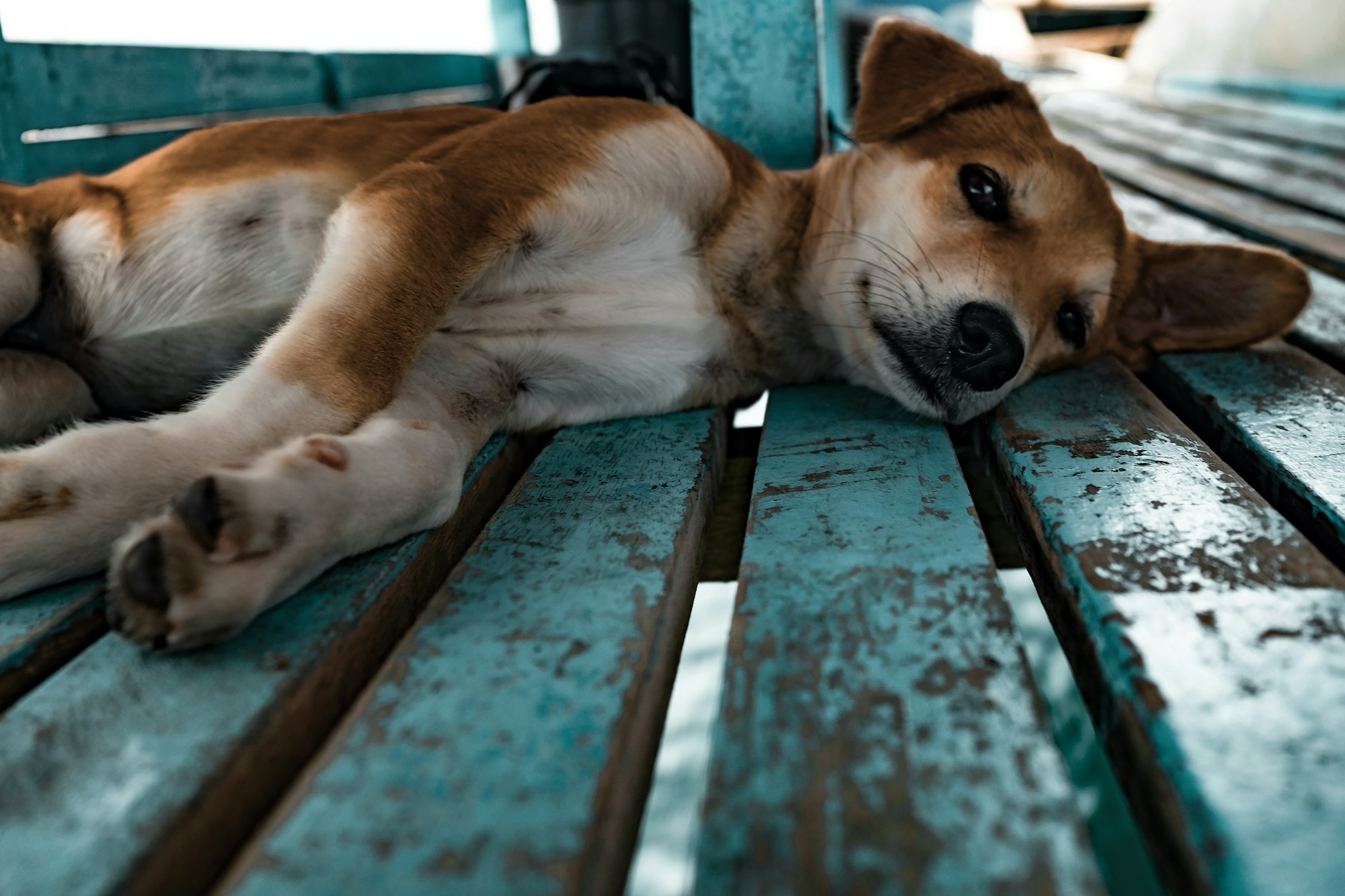Bloat, also known as Gastric Dilatation-Volvulus (GDV), is a distressing and potentially life-threatening condition that can affect dogs of all breeds and sizes. Understanding the causes, symptoms, and preventive measures for bloat is crucial for responsible pet owners. In this comprehensive article, we will delve deep into the world of canine bloat, offering valuable insights and guidance on how to protect your furry friend.

What is Canine Bloat?
Canine bloat, medically referred to as Gastric Dilatation-Volvulus (GDV), is a highly distressing and potentially fatal condition that afflicts dogs, regardless of their breed or size. It manifests as a rapid and alarming accumulation of gas and fluid within a dog's stomach. This abnormal inflation exerts immense pressure on the abdominal cavity, causing the stomach to expand significantly.
The critical and defining feature of canine bloat is the twisting of the stomach upon itself. This twisting impedes the normal flow of blood and gases through the digestive tract, creating a dire situation. As the stomach rotates, it not only compromises blood circulation to the organ itself but can also obstruct nearby blood vessels. This disruption in blood flow can lead to the death of stomach tissues, shock, and systemic organ failure.
Understanding the anatomical underpinnings of bloat is essential. The stomach of a dog is a muscular organ positioned between the esophagus and the small intestine. In the event of bloat, it becomes distended with gas and fluid, increasing in size to a grotesque extent. Subsequently, this enlarged stomach can twist on its axis, causing the life-threatening condition known as gastric volvulus. The twisted stomach further constricts the flow of blood, cutting off the oxygen supply to the stomach lining and surrounding tissues.
Symptoms of Bloat
Recognition of the early signs of bloat is paramount to saving a dog's life. While the symptoms may initially appear subtle, they quickly escalate in severity. Vigilance is crucial, and dog owners should be attuned to the following indicative signs:
a) Restlessness: Dogs experiencing bloat often exhibit pronounced restlessness. They may struggle to find a comfortable position and may pace or repeatedly change their posture.
b) Abdominal Distension: One of the most evident and alarming signs of bloat is the pronounced swelling of the abdomen. The stomach becomes visibly enlarged, taking on an abnormally rounded or distended appearance.

c) Unsuccessful Attempts to Vomit: Dogs in the throes of bloat may repeatedly attempt to vomit, retching with an empty stomach. Despite these efforts, productive vomiting seldom occurs, and the dog's discomfort persists.
d) Excessive Drooling: Bloat often triggers a heightened production of saliva in dogs. This leads to profuse drooling, creating a noticeable and unsightly display.
e) Lethargy: As the condition progresses, affected dogs typically become lethargic, weak, and unresponsive. Their energy wanes, and they may even appear listless.
f) Rapid Breathing: Shallow and rapid breathing, also known as tachypnea, may develop as a result of the pain and discomfort associated with bloat.
g) Pale Gums: Checking the color of a dog's gums is a useful diagnostic measure. In the case of bloat, the gums often turn pale or even bluish due to inadequate oxygen circulation.
h) Rapid Heartbeat: An elevated heart rate, or tachycardia, can be observed in dogs with bloat as the body attempts to compensate for the decreased oxygen supply.
Should a dog exhibit any of these symptoms, it is imperative to seek immediate veterinary care. Time is of the essence in treating bloat, and prompt medical intervention offers the best chance of a successful outcome. Bloat is a veterinary emergency, and delay in treatment can prove fatal. Responsible pet ownership demands swift action when bloat is suspected.
Causes of Bloat
Understanding the underlying causes of canine bloat, or Gastric Dilatation-Volvulus (GDV), is pivotal in both prevention and management. While the precise origins of this condition remain multifactorial and complex, several significant contributors have been identified:
a) Breed Predisposition: Certain dog breeds are at a notably higher risk of developing bloat. Large and deep-chested breeds, such as Great Danes, Standard Poodles, Boxers, and Saint Bernards, are particularly susceptible. This susceptibility is attributed to the conformation of their bodies, which allows for greater stomach mobility and gas accumulation.
b) Age and Gender: Age plays a role in bloat incidence, with middle-aged and older dogs facing a higher risk. Additionally, male dogs are more commonly affected by bloat than females. Hormonal and genetic factors may contribute to this gender discrepancy.
c) Genetic Predisposition: Genetic factors also play a substantial role in bloat. Dogs with a family history of GDV are more likely to experience it themselves. Identifying dogs with a genetic predisposition can aid in early prevention and monitoring.
d) Dietary Factors: Diet plays a critical role in bloat development. Feeding dogs a single, large meal per day, or meals that consist primarily of dry kibble, has been associated with an increased risk. Rapid consumption of food or water, gulping air while eating, and consuming meals from elevated feeders can also contribute to bloat.
e) Stress and Anxiety: High-stress environments or situations can trigger bloat. Chronic stress or separation anxiety can lead to gastrointestinal dysfunction, making a dog more susceptible to bloat. Reducing stressors in a dog's life is an essential aspect of prevention.
Prevention of Bloat
Proactive measures are paramount in mitigating the risk of canine bloat. Responsible dog owners should take the following steps to reduce the likelihood of their canine companion experiencing this potentially life-threatening condition:
a) Dietary Recommendations: Opt for a feeding schedule consisting of multiple smaller meals throughout the day, rather than a single large meal. Feeding a high-quality, easily digestible food with controlled fat content can also be beneficial. If using dry kibble, consider adding water to soften it. Slow-feed bowls can help deter rapid eating.
b) Exercise and Activity: Moderate exercise before and after meals can promote healthy digestion and reduce the risk of bloat. However, rigorous physical activity immediately following a meal should be avoided, as it may increase the likelihood of gastric torsion.
c) Dietary Management: If you have a high-risk breed, consider discussing preventative surgery, known as prophylactic gastropexy, with your veterinarian. This procedure involves attaching the stomach to the abdominal wall, preventing its torsion. While not a guarantee against bloat, it significantly reduces the severity and risk of GDV.
d) Stress Reduction: Maintaining a calm and low-stress environment for your dog is crucial. Reducing anxiety through training, socialization, and a stable routine can help prevent bloat associated with stress.
Treatment for Canine Bloat
When a dog is diagnosed with canine bloat, also known as Gastric Dilatation-Volvulus (GDV), immediate and decisive action is essential. Time is of the essence, and a delay in treatment can prove fatal. The primary goal of treatment is to alleviate the condition's life-threatening effects and stabilize the dog's health. The following steps outline the critical components of treating canine bloat:

a) Emergency Response: Upon recognizing the symptoms of bloat in a dog, swift action is imperative. Contact your veterinarian or an emergency animal hospital immediately. Inform them of your dog's condition and impending arrival.
b) Stabilization: Once at the veterinary facility, the initial focus is on stabilizing the dog. This involves intravenous fluids to address shock, pain management, and oxygen therapy to ensure adequate oxygenation.
c) Decompression: The veterinarian will perform a gastric decompression procedure to release the trapped gas and alleviate the pressure within the stomach. A nasogastric tube is often passed through the nostril into the stomach for this purpose.
d) Surgery (Gastropexy): The definitive treatment for GDV is surgical intervention. During this procedure, the twisted stomach is carefully untwisted, and its position is corrected. To prevent a recurrence, a surgical technique known as gastropexy is performed. This involves attaching the stomach to the abdominal wall to prevent future torsion.
e) Post-Surgery Care: Following the surgical correction of GDV, intensive post-operative care is essential. This includes continued monitoring, antibiotics to prevent infection, pain management, and a carefully controlled diet to support healing.
Risk Factors
Understanding the risk factors associated with canine bloat, or Gastric Dilatation-Volvulus (GDV), is crucial for both prevention and early detection. Several key factors increase a dog's susceptibility to this life-threatening condition:
a) Age and Gender: Age plays a significant role in GDV risk, with middle-aged and older dogs being more prone to this condition. Moreover, male dogs have a higher incidence of bloat compared to females. Hormonal and genetic factors may contribute to this gender disparity.
b) Breeds Predisposed to Bloat: Certain dog breeds are particularly predisposed to GDV due to their unique body conformation. Deep-chested and large breeds, such as Great Danes, Standard Poodles, Boxers, Saint Bernards, and Doberman Pinschers, face a higher risk. These breeds' anatomical characteristics allow for greater stomach mobility, increasing the potential for torsion.
c) Genetic Factors: Genetic predisposition plays a substantial role in GDV risk. Dogs with a family history of bloat are more likely to develop the condition themselves. Responsible breeding practices aim to reduce the prevalence of GDV in susceptible breeds.
d) Dietary Factors: Diet can influence a dog's risk of bloat. Feeding a single, large meal per day, consuming dry kibble, or rapidly ingesting food and water can increase the likelihood of GDV. Therefore, dietary adjustments and controlled feeding practices are crucial for at-risk dogs.
e) Stress and Anxiety: High levels of stress or anxiety can disrupt normal gastrointestinal function and increase the risk of GDV. Reducing stressors in a dog's environment and providing proper behavioral training can help mitigate this risk factor.
f) Previous History of Bloat: Dogs that have experienced GDV once are at a higher risk of recurrence. Owners of dogs with a history of bloat should be especially vigilant in implementing preventive measures.
Complications and Prognosis
Understanding the potential complications and prognosis associated with canine bloat, or Gastric Dilatation-Volvulus (GDV), is essential for both dog owners and veterinarians. While swift intervention and treatment significantly improve outcomes, GDV can have lasting effects on a dog's health.

a) Potential Complications: Complications that can arise from GDV include tissue damage to the stomach and other abdominal organs due to restricted blood flow. In severe cases, this tissue damage can lead to necrosis (tissue death). Moreover, the reduced blood flow can cause systemic shock and organ failure, particularly affecting the heart, liver, and kidneys. Peritonitis, a severe abdominal infection, can also develop as a consequence of GDV.
b) Prognosis with Prompt Treatment: The prognosis for dogs with GDV largely depends on the speed of intervention and the severity of the condition at the time of treatment. When addressed promptly, many dogs can recover successfully following surgical correction. The addition of gastropexy during surgery substantially reduces the risk of recurrence. With diligent post-operative care, dogs can regain their health and lead normal lives.
c) Long-Term Implications: Even with successful treatment, some dogs may experience long-term effects, including dietary sensitivities, altered gastrointestinal function, or behavioral changes related to the traumatic experience. Regular follow-up veterinary care is crucial to monitor for any complications or adjustments needed for the dog's post-GDV life.
Case Studies
Exploring real-life case studies of dogs that have experienced GDV provides valuable insights into the condition's severity and the importance of prompt action. Here are two illustrative case studies:
Case Study 1: Max, a 5-year-old male Great Dane, exhibited classic signs of GDV, including restlessness, abdominal distension, and unsuccessful attempts to vomit. Max's owner recognized the symptoms immediately and rushed him to the nearest animal hospital. Emergency surgery was performed, correcting the torsion and performing a gastropexy. Max made a full recovery with diligent post-operative care and dietary adjustments. His case underscores the importance of quick intervention in high-risk breeds.
Case Study 2: Bella, a 9-year-old female Boxer, had a history of GDV and had undergone gastropexy in the past. One evening, Bella displayed signs of distress, including restlessness and drooling. Her owner, aware of her predisposition to GDV, didn't hesitate and took her to the veterinarian promptly. Despite the recurrence, Bella's previous gastropexy allowed for a less severe torsion. Surgical correction was successful, and Bella once again recovered well, reinforcing the importance of preventative gastropexy in at-risk dogs.
These case studies emphasize the critical role of early recognition, swift veterinary intervention, and preventive measures in managing GDV.
Dietary Guidelines
Proper nutrition and dietary management are integral components of preventing canine bloat, or Gastric Dilatation-Volvulus (GDV). Responsible dog owners should adhere to the following dietary guidelines to reduce the risk of GDV:
a) Choosing the Right Dog Food: Opt for high-quality dog food that is well-balanced and specifically formulated for your dog's age, breed, and size. Consult with your veterinarian to select an appropriate diet that minimizes the risk of bloat.
b) Avoiding Foods that Increase Bloat Risk: Certain foods and feeding practices can elevate the risk of GDV. Steer clear of feeding a single, large meal per day, as well as dry kibble, which can expand in the stomach. Instead, opt for multiple smaller meals throughout the day.
c) Feeding Strategies: Encourage slower eating by using specialized slow-feeder dog bowls or puzzle feeders. Adding water to dry kibble can help soften it, making it less likely to expand rapidly in the stomach. Additionally, discourage rapid consumption of food and water and avoid feeding your dog immediately before or after intense exercise.
Lifestyle Adjustments and Owner’s Role
Discover how managing stress and anxiety, implementing proper exercise routines, and establishing a consistent feeding schedule can reduce the risk of bloat.

As a responsible pet owner, you have to educate yourself about bloat, recognize changes in your dog's behavior, and take swift action if you suspect bloat is occurring.
Conclusion
In conclusion, canine bloat is a condition that every dog owner should be aware of. By understanding its causes, symptoms, and preventive measures, you can help ensure the health and well-being of your beloved pet. Remember, quick action and responsible ownership are key to combating this potentially life-threatening condition.
Frequently Asked Questions (FAQs)
- Q1: What breeds are most susceptible to bloat?
- While any breed can experience bloat, larger and deep-chested breeds, such as Great Danes, Standard Poodles, and Boxers, are more predisposed.
- Q2: Can bloat be prevented with diet alone?
- Diet is one aspect of prevention, but other factors like exercise and feeding habits also play a significant role.
- Q3: Are there any home remedies for bloat?
- No, bloat is a medical emergency, and home remedies are not a substitute for immediate veterinary care.
- Q4: Is bloat common in puppies?
- Bloat is rarer in puppies but can occur in any age group.
- Q5: Can bloat reoccur in a dog who has already experienced it?
- Yes, dogs who have experienced bloat once are at higher risk of recurrence, making prevention even more crucial.




